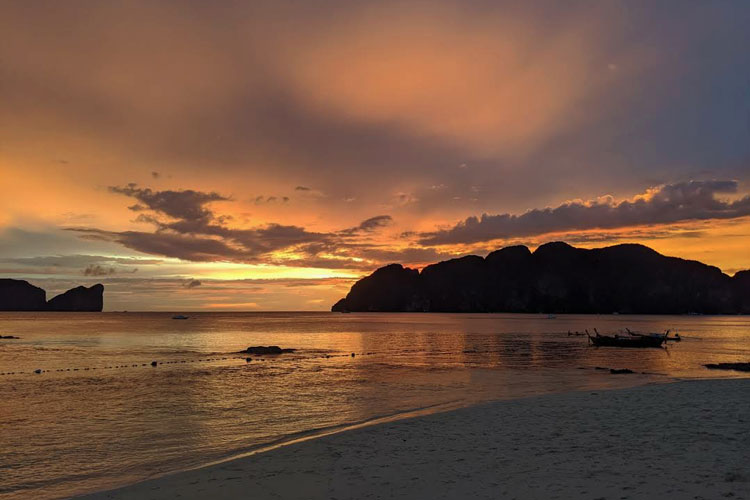This article may contain affiliate links.
Updated: October 30, 2025
Khao Sok National Park is one of the most breathtaking places in southern Thailand. Jungle, limestone mountains, an emerald-green lake, and floating bungalows on the water—all in one incredible spot.
In this guide, I’ll tell you what to see, how to get there, when to visit, and where to stay in this natural paradise. You’ll also find practical tips and a few personal recommendations to help you make the most of your trip.
✅ 2-Day Tour from Phuket with Floating Bungalows stay – absolutely spectacular 🤩
✅ Day-trip from Krabi – best value for money
✅ Minibus from Krabi to Khao Sok – practical and budget-friendly
✅ Boat trip on Cheow Larn Lake – perfect if you’re visiting on your own
Khao Sok National Park
Khao Sok is located in Surat Thani province and is one of the true gems of southern Thailand—a place that will genuinely take your breath away.
It was declared a national park in 1980 and covers 700 km² of tropical rainforest, rivers, caves, limestone cliffs, and a vast emerald lake, home to incredible biodiversity.

Beyond its natural beauty, Khao Sok offers a calm, peaceful atmosphere, far from the crowds of Thailand’s more touristy destinations. It’s the kind of place where you disconnect, hike through the jungle, paddle along rivers, and enjoy absolute peace.
The park is divided into two main areas: the tropical rainforest, full of trails and wildlife, and Cheow Lan Lake, famous for its dramatic cliffs and floating bungalows.
What to Do in Khao Sok
1. Tropical Rainforest
Khao Sok’s rainforest is one of the oldest on the planet—even older than the Amazon, and you can tell. Everything here is big: the trees, the leaves, the sounds… and the humidity, which wraps around you from the very first minute.
🔹 Hiking trails
Walking through this jungle is a unique experience, surrounded by dense vegetation, waterfalls, caves, and small streams.
There are nine hiking trails of varying difficulty—some short and easy to do on your own, others more challenging and best done with a guide. Most are well-marked.
At the park office, you can ask for a map and check which trails are open depending on the season.
Below you’ll find a general map of the park, and in this other article, you can check out all the maps of Khao Sok— one with the park areas, another with the jungle hiking trails, and one of the lake.
🔹 Wildlife
If you pay attention, you might spot gibbons or langurs swinging through the trees and, with a bit of luck, find tapir or elephant tracks. From my experience, it’s easier to see wild elephants bathing than walking along the trails.
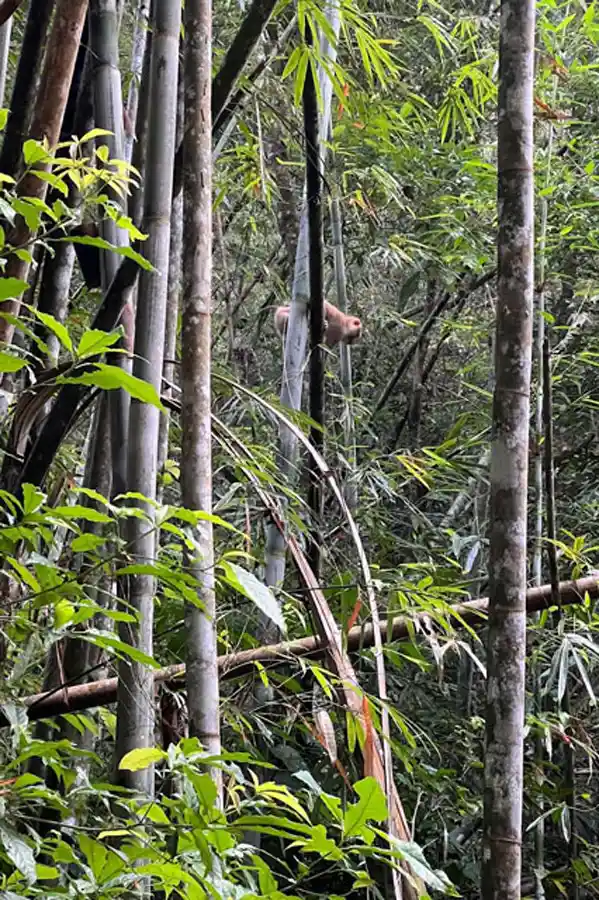
You’ll have better chances of spotting wildlife if you join a guided jungle tour.
The sounds of the jungle are part of the magic—tropical birds, crickets, and sometimes that deep, heavy silence that makes you feel like you’re in a lost world.
👍 Friendly Tip: If you care about animals, avoid places that use them as attractions, even inside the park. They’re not ethical. It’s much better to see them in the wild. In this other guide, I share my experience and the truth about elephants in Thailand.
🔹 Flora
The park’s flora is truly fascinating. Between December and February, the Rafflesia arnoldii—the largest flower in the world—blooms. It’s enormous and impressive… though its smell isn’t exactly pleasant. Let’s just say it’s best admired from a distance.
🔹 Canoeing and Rafting
If you’d rather explore with less effort, you can do it from the water. Canoe or rafting trips along the Sok River are a peaceful way to enjoy the scenery.
Paddling among limestone mountains covered in lush greenery is one of those moments that remind you exactly why you came to Thailand.
2. Cheow Lan Lake
Cheow Lan Lake, also known as Cheow Larn, is the real gem of Khao Sok. It covers over 185 km² and is surrounded by limestone mountains that reflect beautifully on the water.
Once you’re there, you’ll understand why I always recommend visiting Khao Sok — it’s a true must-see in Thailand.

This area looks a lot like Phang Nga Bay or even Halong Bay in Vietnam.
It’s actually an artificial lake, created in 1982 after the construction of a dam, but it looks so natural it’s hard to believe. Today, it’s one of the most photogenic spots in southern Thailand and a part of the park that’s well worth visiting, even if only for a day.
🔹 Boat trip
One of the best ways to explore the lake is on a traditional Thai longtail boat. Most tours include several stops for swimming, kayaking, or simply relaxing in the middle of the lake with the gentle sound of the water all around you.
🔹 Coral Cave
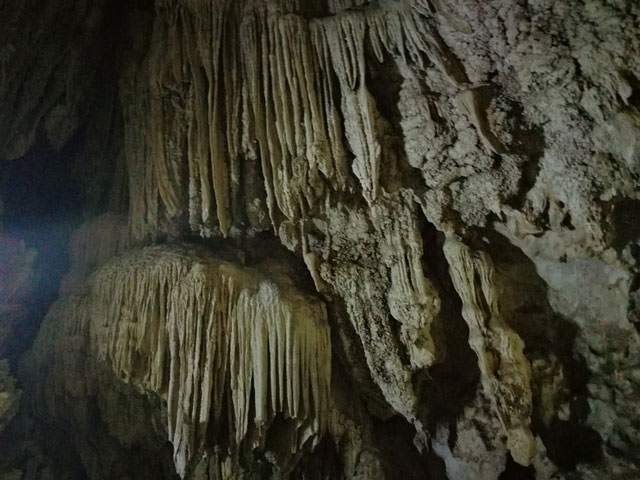
One of the most popular stops is Coral Cave, a centuries-old cave filled with beautiful stalactites and stalagmites.
To get there, you’ll cross the lake by boat, walk a short trail through the jungle, and then continue on a bamboo raft. The journey itself is an adventure.
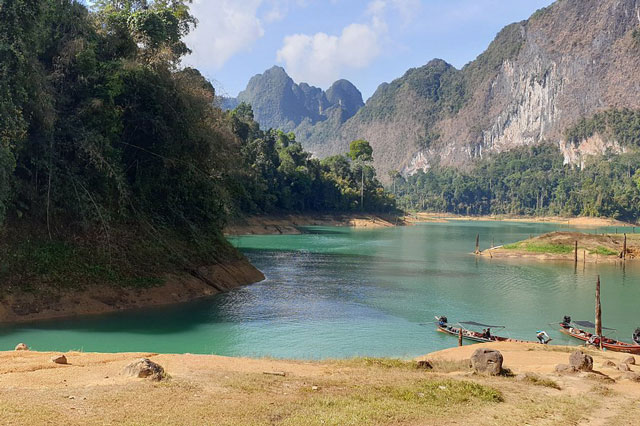
🔹 Floating bungalows
If you’re after something unique, spend the night in one of the lake’s floating bungalows.
They’re simple (and not exactly cheap), with limited electricity and no internet, but waking up to the mist rising over the water is absolutely priceless.
In the morning, when the lake is completely still and the only sounds are the birds, you’ll understand why this is considered one of the most magical places in Thailand. A truly unforgettable experience!
✅ Friendly Tip: Don’t forget to get travel insurance for your next adventure. I recommend Heymondo,—it’s super comprehensive, and with that link, you’ll get 5% off.
Map

How to Get There
The park is located in Surat Thani province, near Krabi and Phuket, so it’s easy to include it in your southern Thailand itinerary.
If you’re traveling on your own, you can get there by bus, minivan, or rental car. And if you prefer not to deal with logistics, there are also organized tours.
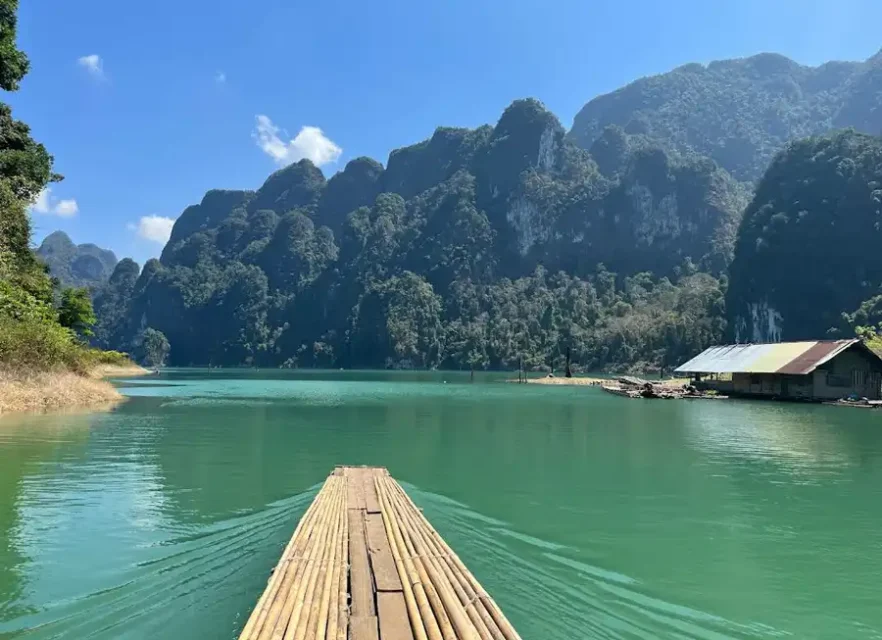
1. Public transportation
If you’re coming from Bangkok or northern Thailand, you’ll need to head south. The easiest option is to fly to Surat Thani (you can book your ticket here).
You can also reach Khao Sok from other southern destinations by bus or minivan:
- Surat Thani: The trip takes about 1 hour 30 minutes, costs from around €5, with departures starting at 7:20 a.m..
- Krabi: It takes a minimum of 3 hours 30 minutes, prices from €9, with departures from 7:00 a.m. from Ao Nang and Krabi town.
- Phuket: The trip takes about 3 hours, prices from €8, with departures from 6:00 a.m.
- There are also direct buses from Khao Lak and Phang Nga.
On this website you can see updated schedules, prices, and book your tickets.
2. Car
If you plan to spend one or more nights in Khao Sok and want to explore at your own pace, renting a car is the best option.
The roads from Krabi and Phuket are in good condition, and the drive only takes a few hours.
To rent a car in Thailand, I recommend this website — which the best prices. I’ve rented cars for as little as €12 / 14 USD per day in Krabi and Phuket. 😉
3. Organized tour
If you’d rather skip the hassle of planning, you can book a one- or two-day tour with accommodation, departing from Krabi or Phuket.

These tours include transfers, a jungle guide, park activities, and a boat trip on the lake — a super convenient option if you’re short on time.
Here are my top picks, from:
- Krabi: Cheow Lan Reservoir day trip, including a boat ride, jungle walk, kayaking, and lunch. It’s the most affordable option.
- Phuket: Two-day trip with accommodation in floating bungalows— this is the one I joined, and I was lucky enough to see wild elephants. ❤ It includes meals and transfers from Khao Lak or Phuket, making it the most complete option.
How to Get Around the Park
If you arrive by bus, the main stop is in Khao Sok village, just a few minutes from the park entrance. Many accommodations offer free pick-up from there.
To get around on your own, you can rent a motorbike (250–300 baht per day) or hire a private driver if you’d rather not drive.
If you want to explore the jungle with a local guide, I recommend this tour that includes a jungle hike and a stop at some waterfalls for a refreshing swim. The guide is super friendly, knows a lot about the local wildlife, and will help you spot some of it.
To visit Cheow Lan Lake, this private longtail boat tour is a great option — it includes several stops for swimming, taking photos, and enjoying the stunning views.
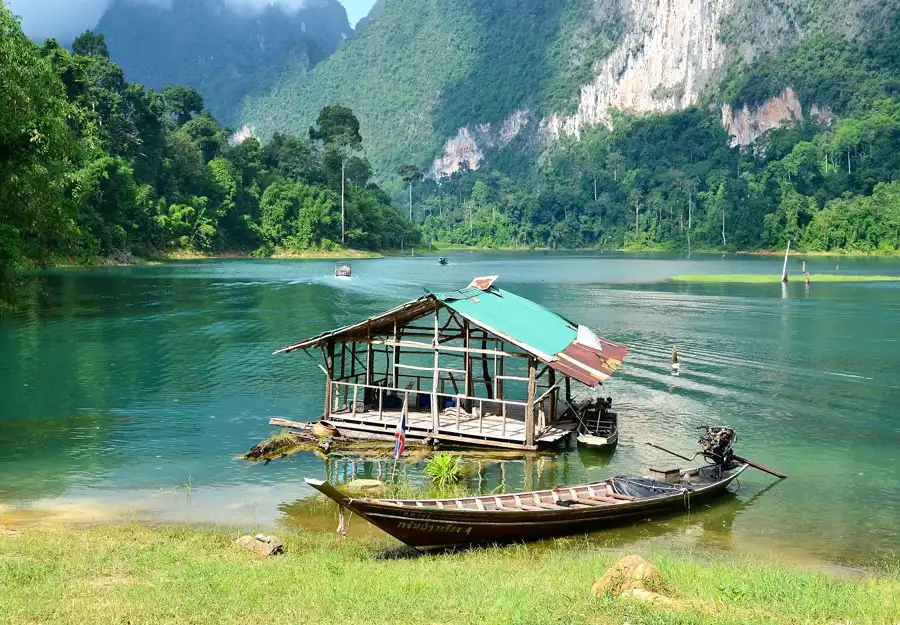
Entrance Fee
The entrance fee to Khao Sok National Park is 300 baht per adult and 150 baht per child (as of 2025). Some tours already include this in the price.
👉 Other additional costs:
- Coral Cave entrance: 200 baht per adult / 100 baht per child.
- Khao Sok Pier Fee: 40 baht per person.
- Parking near the lake pier: 80 baht per car per night.
Where to Stay
You can stay in Khao Sok in two main areas: the village, near the jungle, or the floating bungalows on Cheow Lan Lake.
It all depends on your budget, how long you’re staying, what you want to explore, and the kind of experience you’re looking for. From my experience:
✔️ Accommodation in the village
The village is peaceful, with little nightlife, but plenty of restaurants and accommodation options.
Prices are very reasonable, and the bungalows are usually simple but charming.
If you’re looking for something budget-friendly, Monkey Bungalows is perfect. Depending on the season, a night costs under 40 euros. It’s where I stayed the first time I visited.
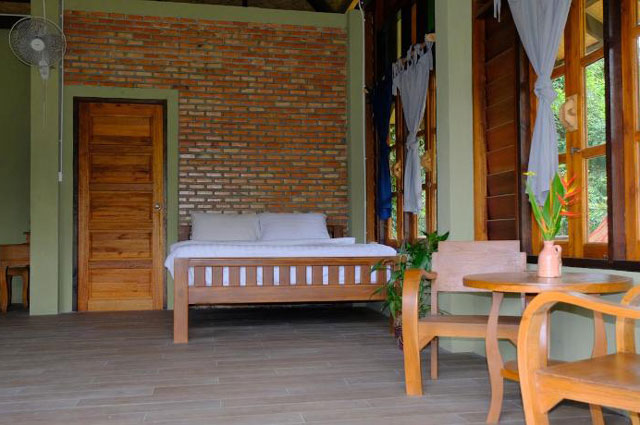
If you prefer something more comfortable, Lalalune is very cozy and well located. I loved their breakfast — delicious and made with fresh ingredients.
Another advantage of both places is that they have free parking.
👍 Friendly Tip: For food, I recommend Pawn's Resturant (👈 Google Maps link). They have a generous, tasty pad thai at a great price. 😋
✔️ Accommodation on Cheow Lan Lake
The floating bungalows in Khao Sok are an unforgettable experience — a bit pricier and with basic amenities, but totally worth it. If you can, stay at least one night; you won’t regret it.
It’s pure bliss to relax with a drink in your little bungalow at night — the peace and quiet are incomparable. And in the early morning, when you wake up to see the mist floating over the lake… it’s truly magical.
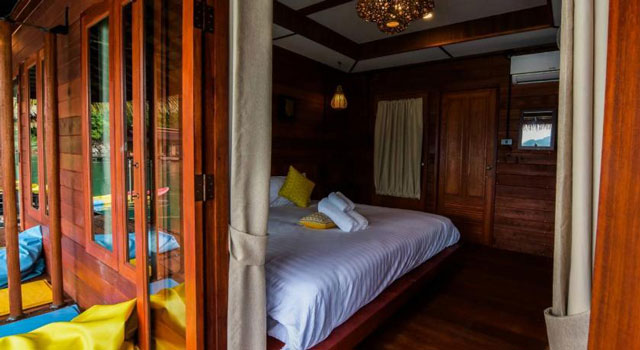
Here are my recommendations:
- €€€€ 500 Rai Floating Resort : fantastic location, very comfortable and the best on the lake.
- €€€ Panvaree The Greenery: great value for money. It’s where I stayed, and I’d happily go back. The food was amazing, and the included boat trips were the cherry on top.
- €€ Panvaree Resort: reasonable prices and beautiful views.
👍 My two cents: There are many options on the lake, but quality varies a lot. Check photos and reviews carefully — some bungalows are literally falling apart. 😬 Also, book early if you’re traveling during high season.
🤑 If you want to save on your next adventure, use this link from Booking to get 15% off your stay.
FAQs
Khao Sok National Park is in one of the rainiest parts of Thailand, which is what keeps it so lush and beautifully green.
- The wet season runs from May to Octobermonsoon rains really pour down. This isn't the best season for hiking — the trails get very muddy.
Still, the park is stunning: it usually rains for a short while and then clears up. During these months, you’ll also find leeches — not dangerous, just a bit gross (at least to me). Cover your legs and avoid swimming in the rivers.
- The dry season runs from November to April, with February being the driest and best month to visit Khao Sok.
The weather is tropical, so even in the dry months, you might get the occasional shower. Temperatures range between 24°C and 31°C, with pleasantly cool nights — perfect for sleeping.
To give you an idea, below you’ll find a chart showing Khao Sok’s average annual high and low temperatures: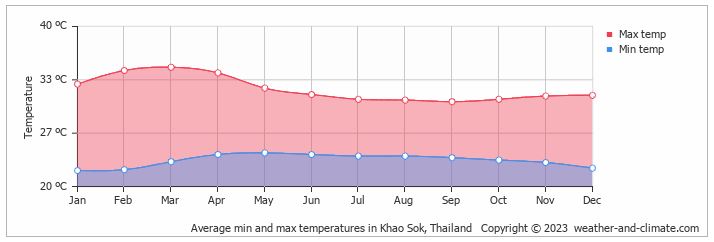
Source: Weather and Climate
Ideally, spend two nights — one in the village (to explore the jungle) and another on the lake (to stay in a floating bungalow). That way, you can enjoy both areas without rushing.
Yes, absolutely. You can get there by public transport (as mentioned above), rent a scooter, and explore the trails on your own.
That said, some activities — like boat trips on the lake or night walks — can only be done with a licensed guide.
If you plan to explore both the jungle and the lake, here’s what you shouldn’t forget:
• Swimsuit
• Sunscreen
• Repellent (essential, bring one with DEET ✌)
• Waterproof hiking shoes
• Headlamp (optional, but great for saving your phone battery)
• Rain jacket
• Dry bag (to keep your things safe during excursions)
• Waterproof phone case
• Long pants, especially during rainy season
⭐ You may also be interested in this other article about What to Pack for Southeast Asia

In the park, especially around the lake, you’ll only get signal if you use an AIS SIM card. It’s the provider with the best coverage in Thailand, even in rural areas and on islands.
Another good option is a Holafly eSIM, which uses the AIS network and offers unlimited data. You can check the details and get a 5% discount through this link.
👍 Friendly advice: AIS isn’t perfect. If you have a meeting or something important that requires a stable connection, don’t leave it for when you’re in the park (especially not on the lake).
The floating bungalows on the lake are usually eco-friendly, so they don’t have electricity for most of the day — power is generally available only at night.
Charge all your devices beforehand, and if you can, bring a solar power bank — super handy for keeping everything charged without relying on outlets.
Final Thoughts
Khao Sok National Park is one of those places that truly leaves you speechless — wild nature, deep peace, and landscapes that look straight out of a movie. Jungle, caves, waterfalls, a dreamlike lake, and the chance to sleep in a floating bungalow… what more could you ask for?
If you’re planning your southern Thailand route, don’t skip it. I promise the journey to get here is worth every minute. For me, it was one of the most beautiful places I visited in the whole country.
If you have any questions, leave me a comment below and I'll help you as much as I can. If you found the article useful, share it with other travelers. Have a good trip! 😘
More about Southern Thailand
More about Thailand

Hi, I’m Andrea, creator and author of Viajeros Activos (Active Travelers). I write about Southeast Asia, the Caucasus, and Europe. I’m a full-time traveler, passionate about good food, and always looking for new adventures.
